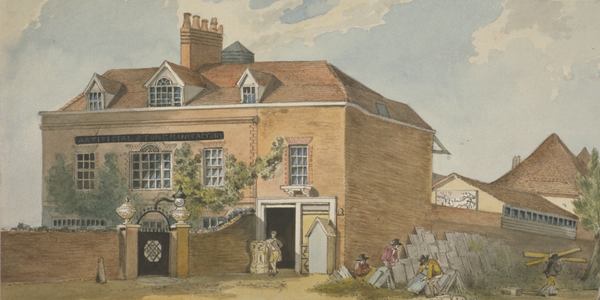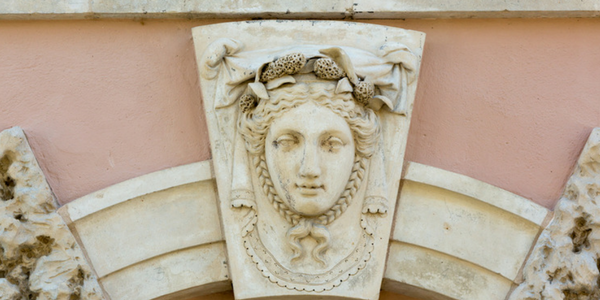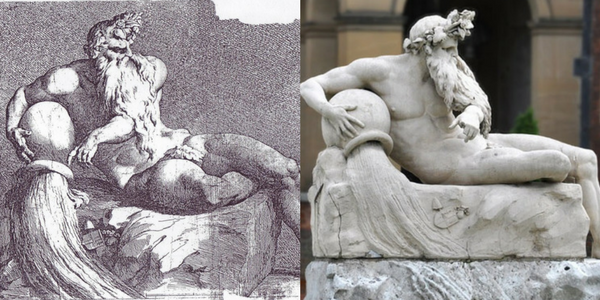 Eleanor Coade's factory in Lambeth, London. Image: London Metropolitan Archives, City of London
Eleanor Coade's factory in Lambeth, London. Image: London Metropolitan Archives, City of London
Mrs Eleanor Coade (1733-1821) was a remarkable woman whose life and achievements went largely unsung until recently (and Landmark’s restoration has gone a long way to redressing this). Eighteenth-century business women are few, and even those we know of were almost always wives or widows carrying on their husband’s business. Not so Mrs Coade: she never married and ‘mistress’ was a courtesy title.
In 1769, with her mother, she took on a failing artificial stone manufactory in Lambeth, London, where the South Bank arts complex stands today. We don’t know where she got her interest in ceramics – her father was a serial bankrupt – but it’s clear she soon imposed her formidable personality, sacking the previous manager Daniel Pincot. She took charge and changed the brand name from Lithodypyra (‘twice fired stone’) to the snappier ‘Coade stone.’
It is this Coade stone that adorns the beautiful exterior of Belmont today in the form of sea creatures, quoins and series of urns along the parapet. Most other ‘artificial stones’ or plasters used for architectural embellishment harden through chemical reaction with the air, but Coade stone was fired in kilns. It was made of raw ball clay carefully mixed with pre-fired, ground up terracotta or ‘grog’, and a sprinkling of ground glass, flint or other silicates.
 Durable Coade stone on the exterior of Belmont in Lyme Regis
Durable Coade stone on the exterior of Belmont in Lyme Regis
This formulation was varied according to the size of the finished piece, and during the firing in a wood-fired kiln it shrank at a highly predictable rate, so that objects could be reliably replicated – important for use in architecture. Everything from the smallest medallion to bigger than life-size statues could be replicated.
Mrs Coade did not invent the formulation or the process; Pincot has a better claim to that, and even he was building on stoneware technology developed in England since the late 17th century. Mrs Coade’s genius lay in her quality control and her entrepreneurship. First, she persuaded some of the finest sculptors of the day to create the models for her reliably indestructible wares, artists like John Bacon and Joseph Panzetta.
And then Mrs Coade convinced the world that the resulting works were not only indistinguishable from natural stone but better than natural stone, for their colour and their hardness and resistance to frost. It’s no overstatement to say that Coade stone transformed late-Georgian architecture: without Mrs Coade, the buildings of the Adam brothers, Sir John Soane, the Wyatt dynasty and many others might have looked very different.
 The River God at Ham House, Surrey is one of many sculptures created with Coade stone. Left image: Sir John Soane's Museum
The River God at Ham House, Surrey is one of many sculptures created with Coade stone. Left image: Sir John Soane's Museum
But Coade stone also transformed many humbler homes. If you walk the streets of Bloomsbury in London, or Southernhay in Exeter, you will find many a Coade stone face peeping out above an eighteenth-century door, flanked by clever vermiculated Coade stone quoin blocks, all identical but when placed upside down, providing a variegated mirror image.
Learn more about Eleanor Coade and Belmont
Where to find Coade stone
'Revisiting the origins of Coade Stone' by Caroline Stanford (pdf)
John Fowles' creative legacy at Belmont
Webinar: 'Celebrating Mrs Eleanor Coade and the restoration of her seaside villa, Belmont in Lyme Regis' by Caroline Stanford (YouTube)
Visiting Belmont